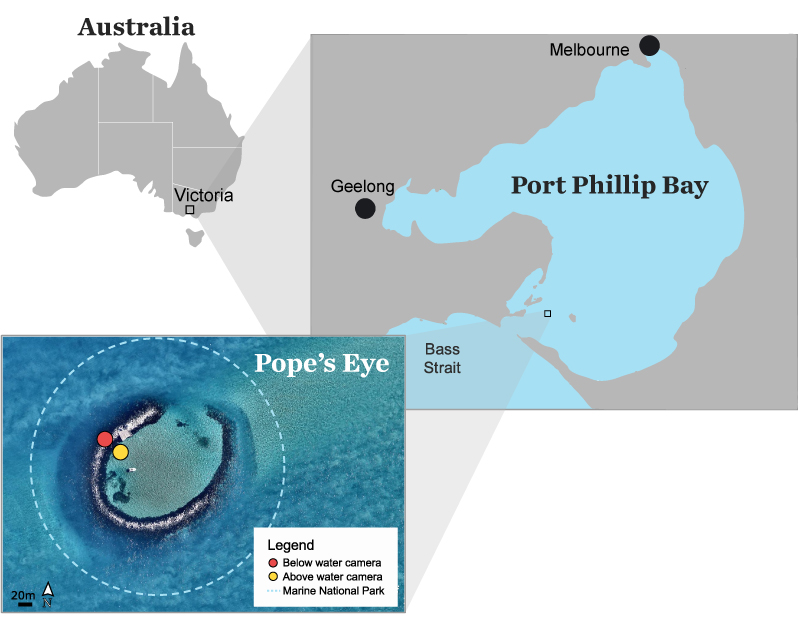Underwater Reef Cam
Watch nowReef Cam is Australia’s first ever rocky-reef, live-feed, combined under and above water webcams. Check out our own reality show staring some of Port Phillip Bay’s coolest residents – the local flora and fauna – including those from deep under the sea!
In early 2023, TNC handed over operation and management of Reef Cam, now known as The Great Southern Reef Camera Network, to our friends at Southern Ocean Environmental Link (SOEL). As a not-for-profit organisation based in Queenscliff, SOEL are just a short boat trip from the camera location. There is much more in store for Reef Cam so stay tuned as SOEL builds on TNC’s legacy!
Please note: The webcam is solar powered and therefore only operates during local daylight hours and when there is enough sun. A pre-recording will be shown when the live feed is offline.
From time to time the webcam will be temporarily turned off when scientists are engaged in webcam maintenance or research activities.

Why does Reef Cam exist?
Awareness of the value of Australia’s southern, temperate marine life is often overshadowed by attention on the tropical Great Barrier Reef – despite the unique marine life, picturesque seascapes and world class diving available in the south.
To address this, we established Australia’s first live-stream, marine webcams combining stunning under and above water views, in Port Phillip Bay, right in Melbourne’s front yard.
Where is Reef Cam?
Situated in the heart of Port Phillip Bay at Pope’s Eye, the webcams open up Victoria’s underwater world to global audiences and provide a new environmental monitoring station for the Bay.

Pope’s Eye was the ideal location to install the Reef Cam infrastructure (including a solar energy system and other electronics) due to the available above-water views of abundant seabirds on the jetty and underwater views of the marine life below.
What is Reef Cam used for?
Education and awareness
- Reef Cam has many benefits and can be used to:
- Build awareness about the value of Victoria’s marine life.
- Support the annual Great Victorian Fish Count, run by the Victorian National Parks Association’s Reef Watch Program, where remote schools (e.g. Mildura, Albury) in Victoria can now participate in the event by viewing Reef Cam.
- Assist teachers as a tool to educate students about marine life.
Research
Reef Cam plays an important role in monitoring the health of Port Phillip Bay through the underwater science node (not yet available) which collects water quality data in real time. This data will be integrated in the EPA’s bay-wide monitoring program and nationally into the Integrated Marine Observing System (IMOS).
In addition, Reef Cam also has potential research benefits through partnerships with Parks Victoria and Deakin University who use the above water camera to monitor the Australiasian Gannets.
Over the next few years we are aiming to operationalise machine learning and image recognition technology so that Port Phillip Bay’s marine life can be monitored electronically and in real-time via the live streams. The data generated will be incorporated into research to track the health of the bay and inform management decisions.
Who uses Reef Cam?
Reef Cam is available for everyone to view and use including:
- Divers and boaters checking out the bay’s conditions before heading out on the water.
- Teachers providing marine education for students.
- Researchers monitoring the health of the Bay to inform management decisions.
- Researchers monitoring Australasian Gannets.
- People around the world who can appreciate and marvel at our unique marine life.
Installing Reef Cam
We worked with Kina Diving (infrastructure construction) and Ocean Blueprint (webcam supplier) to establish the technical design of all webcam infrastructure, site selection and installation.
All installation works were carried out in line with Parks Victoria’s issued Scientific and Works Permits, with every care taken to respect the natural values of this unique location.
Above-water camera
The above-water webcam has a self-cleaning arm that keeps the field of view free of ocean mist and rain. It commonly features the resident gannet colony, as well as breaching seals and other passing marine animals such as dolphins.
An insulated power cable runs from the solar battery box through the intertidal zone down to the underwater webcam and science node. All above-water infrastructure was placed to minimise any disturbance of the resident gannet colony and be moveable in case there are any major upgrades of the Pope’s Eye jetty area by Parks Victoria.
Parks Victoria Office Infrastructure
In order to connect the webcam footage to the internet, it was necessary to install further infrastructure at the Parks Victoria office.
The radio transmitter fitted at Pope’s Eye relays the live footage to the pictured acceptor radio. From the roof, the transmitter is connected via ethernet cable to the server room in the office then connected to a router and remote work station. This is the point the live footage is plugged into the internet and whereby we can gain remote access to the webcams.
What’s next for Reef Cam?
We are developing ongoing partnerships for Reef Cam that will involve:
- Deakin University – to develop the machine learning and image recognition technology to add value to existing monitoring programs.
- Integrated Marine Observing System and the EPA – to integrate the science node water quality data into existing monitoring programs.
- Creating and sharing educational resources and interpretative exhibits with organisations such as Sea Life Melbourne Aquarium, Museum Victoria and Zoos Victoria.
- Information sharing and support on how to establish remote webcams.
- Encouraging promotion to raise awareness of Reef Cam and related activities.
Thanks to support from the John T Reid Charitable Trusts, Reef Cam is an important element of our Oceans program.
All installation works were carried out in line with Parks Victoria’s issued Scientific and Works Permits, with every care taken to respect the natural values of this unique location.
Watch the underwater live feed
Be mesmorised by the underwater seascape of Port Phillip Bay.




